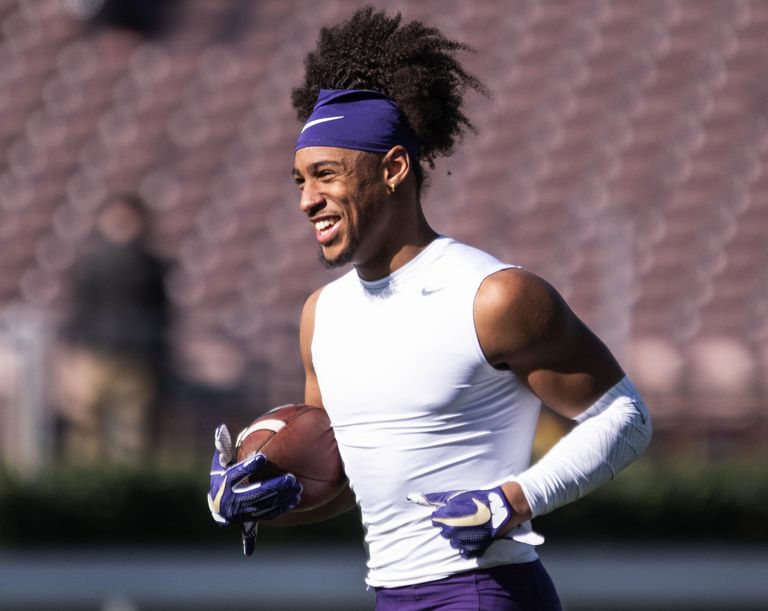He’s retired from competitive dance and kung fu, but Washington DB Kyler Gordon is still Mr. Spotlight
By Mike Vorel The Seattle Times (TNS) Apr 23, 2019 Updated Apr 23, 2019

SEATTLE — Kyler Gordon was an athlete before he was anything else.
Before he was a football player, a Husky, a four-star corner and a national recruit; before he was a Seattle Storm dancer and a kung fu fighter; before he was Mr. Spotlight, Kyler Gordon was already stealing it.
“Before he was a year old, his grandma and grandpa were like, ‘Uh, there’s something special about this little boy. He’s going to be something,’ ” Kyler’s mother, Evamarie Gordon, told The Seattle Times last week.
“It’s really weird. I know it sounds kind of stupid, but I had a vision as well. I just knew in my heart that there was something about him.”
Something, but what? Kyler was walking at nine months old. He was attempting somersaults and cartwheels before his first birthday. When he was 4, he tried kung fu, just for kicks. He dipped his fleet feet into dance — ballet, jazz, hip hop, lyrical, you name it — a year later. He used to stretch while watching cartoons to improve his flexibility.
Occasionally, Evamarie — a gymnastics coach — would take her son/pre-teen slinky with her to the gym, which is where he learned a backflip. For four years, Kyler devoted 20 hours a week to dance classes (and that’s not counting competitions).
At age 8, he moonwalked his way to being named “Mr. Spotlight” — with a pink bow tie and curly brown hair to boot — at the Spotlight Dance Cup national finals in California.
“Google him on the internet and you’ll see him,” Evamarie Gordon said. “It was like, ‘Oh my gosh.’ One of the guys from Broadway was one of the (competition’s) judges and he said, ‘This kid is going to go somewhere in the industry.’ ”
Kyler Gordon found football instead.
Or, maybe it’s more accurate to say that football found him.
“When he got to the field, I’ll never forget it,” Evamarie Gordon said of her 9-year-old son. “They’re like, ‘Where’s this kid been?’ I’m like, ‘He’s a dancer. He’s been in dance.’ ”
Despite adding yet another outlet for his athleticism, Kyler didn’t stop dancing. He joined the Seattle Storm’s hip hop dance troupe at age 9, performing at home games and events (while still making it to football practice). The activity itself almost seemed insignificant; Kyler’s athleticism was a universal currency, accepted everywhere. If he participated, he dominated — whether it be dance or defense.
“Everybody wanted him to play everything,” Evamarie Gordon said. “He did football. He did basketball. It didn’t matter what he did. He’d kill it.”
So it was that a budding defensive back, former kung fu fighter and decorated dancer arrived at Archbishop Murphy High School in Everett in the fall of 2014.
The question was never whether Kyler Gordon would be successful. The question was where, and the options were endless.
“When we saw Kyler as a freshman we could tell that he was special,” said Archbishop Murphy head football coach and former Washington linebacker Jerry Jensen. “He had a high ceiling in basically whatever he decided he wanted to do, whether that be track or football or basketball. He would have success at it.
“He really kind of took to football and worked on the craft and that allowed him to get his strength up. But the thing that really impressed me most about Kyler is probably his flexibility. That allows him to move as fluidly as he does and as effortlessly as it looks.”
It was effortless, and it was everywhere. In his senior season in 2017, Kyler was named to the Associated Press 2A all-state team both as a defensive back and an all-purpose player. The 2017 Star Times selection rushed for 517 yards and 12.9 yards per carry, caught 32 passes for 841 yards, threw an 88-yard touchdown pass and piled up 44 tackles and five interceptions. He averaged 19 yards per touch and was named offensive MVP of the Cascade Conference. He jumped as if each strip of turf was its own tiny trampoline.
And he put things on tape that Jensen had never seen.
“You would just see Kyler’s break on the ball or a one-handed catch or he would go up between two defenders and come down with the ball,” Jensen said. “He’s just a kid that has innate ability to rise above others and make plays.”
Was it innate, though? Were those physical gifts — the balance, the body control, the reflexes and instincts — just something he was born with? His mother was a gymnast and his aunt was a dancer, after all.
Or maybe that unique athletic background — the ballet, the kung fu, the Storm games and dance competitions and Mr. Spotlight crowns — all molded Kyler into a pass-catching, pick-snatching football machine. Perhaps each activity ultimately contributed to the final product, a four-star prospect ranked by 247Sports as the No. 102 overall player in the 2018 class.
Was it nature, nurture or a little bit of both?
“I think if you look at his background with dance, obviously that would help with his feet. Then kung fu (would help) with his stretching,” Jensen said. “You can see how those things just apply themselves to his athleticism.
“It just doesn’t look like he’s straining and overworking to do these things that you look at and they’re just jaw-dropping. So I do think those things played a key role in where he ended up as an athlete.”
Specifically, he ended up at Washington, where Kyler played in four games as a freshman and then essentially wrecked the competition at the Husky Combine last month. The redshirt freshman cornerback finished first on the team in the vertical jump (42.5 inches), second in the 3-cone drill (6.52 seconds) and pro agility drill (3.87 seconds) and third in the broad jump (10 feet, five inches).
But inside the program, at least, Kyler’s thorough domination didn’t open many eyes.
“We go play pick-up basketball and he’s dunking,” said senior defensive back Myles Bryant, “so that 42.5 (inch vertical jump) wasn’t a surprise.”
Still, a starting spot in his second season is far from a slam dunk. Through two and a half weeks of spring practice, Kyler — who, as a redshirt freshman, is not available to the media, by the way — has been sharing first-team reps with fellow redshirt freshman cornerback Dominique Hampton, opposite established starter Keith Taylor.
Kyler has always been an athlete. Now, he needs to prove he can play in the Pac-12.
“He’s got really good ball skills, which you know we’re always looking for in our corners — to be playmakers on the football,” defensive coordinator Jimmy Lake said last week. “Him and Keith Taylor are tied for the best hands in the room right now. They’ve got two picks apiece. So I’m expecting those guys to have a really good battle here for the rest of the camp.
“But Kyler’s athletic, can jump, can move side-to-side. It’s really more about him continuing to grow, continuing to attack the football and getting his man skills at a higher level, which he’s working at right now.”
Kyler’s still working, studying — and in between drills, he’s definitely dancing. He’s showing no signs of stopping.
His mother makes sure of that.
“I tell him, ‘You know what? There’s other kids better than you.’ So I think that’s why he’s so humble and quiet,” Evamarie Gordon said. “He has the love and passion for it. He knows there’s kids better than him, but he pays no mind to that.
“He’s always hard on himself and he knows he can do better, and he keeps pushing.”
The end goal, of course, is to crack a ridiculously deep rotation in Washington’s defensive secondary. It’s to demonstrate that a rebuilt defense can still produce the same results. It’s to star once again on a different kind of stage.
It’s to prove he’s still Mr. Spotlight.
Watch out. He’ll steal the show.





 Reply With Quote
Reply With Quote




/cloudfront-us-east-1.images.arcpublishing.com/pmn/QPDOPJT6GND27C6QLE3LXYJC6Y.jpg)
/cloudfront-us-east-1.images.arcpublishing.com/pmn/MSUKC5Z4TJDHVMGO2XC7PB6FK4.jpg)
/cloudfront-us-east-1.images.arcpublishing.com/pmn/GO5WQC6BSZAURIXX2QDZFMFFAQ.jpg)
/cloudfront-us-east-1.images.arcpublishing.com/pmn/BJYRIUSH2ZCZ7IPQPVJAN6C2AI.jpg)
/cloudfront-us-east-1.images.arcpublishing.com/pmn/T5UEL3W2RRD6XEN7W4P6XTEBUU.jpg)
/cloudfront-us-east-1.images.arcpublishing.com/pmn/IQYKVUY7MFHJ5LT7EU4G7D7SXQ.jpg)
/cloudfront-us-east-1.images.arcpublishing.com/pmn/LNYZ6DWN2FCLTM6JVF2EJJ52BM.jpg)
